|
A
Philatelic Introduction to B.A.E. II: Cancellation Types
by
Paul
Skowron, ASPP
FIRST
CANCELLATION
VARIETIES
ALL
TYPES USED BY LEROY CLARK IN 1934
MACHINE
CANCELLATIONS
TYPE
I

7
KILLERS
JAN.
30, 1934
CLARK
TYPE
|
TYPE
II

7
KILLERS
JAN.
30, 1934
CLARK
TYPE
|
TYPE
III

7
KILLERS
JAN.
31, 1934
CLARK
TYPE
|
HAND
CANCELLATIONS
NOTE:
NOT EXACT SIZE AS ORIGINAL; SOME DETAILS OMITTED FROM DIAL
TYPE
I
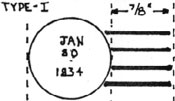
|
- SHORT
KILLERS WRAP AROUND DIAL
- JAN.
30 1934 DATE
- "GAP"
BETWEEN '30' AND '1934'
- NO
'TIME' IN DIAL
|
TYPE
II
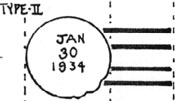
|
- SHORT
KILLERS WRAP AROUND DIAL
- JAN.
30 1934 DATE
- NO
"GAP" BETWEEN '30' AND '1934'
- NO
"TIME" IN DIAL
- DIAL
DISTORTION AT 5 O'CLOCK POSITION
|
TYPE
III
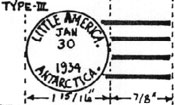
|
- SHORT
KILLERS WRAP AROUND DIAL
- JAN.
30 1934 DATE
- "GAP"
BETWEEN '30' AND '1934'
- NO
"TIME" IN DIAL
- PERIOD
AFTER 'LITTLE AMERICA' & 'ANTARCTICA'
|
FIRST
& SECOND CANCELLATION VARIETIES
1934
POSTMARKS USED IN 1935
(
BY CHARLES F. ANDERSON )
MACHINE
CANCELLATIONS
NOTE:
NOT EXACT SIZE AS ORIGINAL; SOME DETAILS OMITTED FROM DIAL
TYPE
IV

6
KILLERS / JAN 31, 1934 DATE / ANDERSON TYPE
|
These
types were used by Anderson to finish remaining mail "uncancelled"
by Clark, or to redo improperly done covers. Hand cancel usage is
normally found on covers with multiple franking (e.g. blocks), or
where the postmark of a machine cancel is unreadable. In most cases
the cancel has been turned or the killers masked out to avoid covering
cachets or an address. All were marked with a San Francisco receiving
cancel on the back of the cover. |
HAND
CANCELLATIONS
TYPE
IV

|
- LONG
KILLERS WITH STRAIGHT SIDES
- JAN.
31 1934 DATE
- 8:30
PM TIME IN DIAL
- DIAL
DISTORTION ( 2 & 5 O'CLOCK)
- BOTTOM
BAR OFFSET 1/32"
|
TYPE
V

|
- LONG
KILLERS WITH STRAIGHT SIDES
- JAN.
31 1934 DATE
- 8:30
PM TIME IN DIAL
|
TYPE
VI
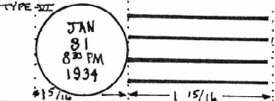
|
- MEDIUM
LENGTH KILLERS WITH STRAIGHT SIDES
- JAN.
31 1934 DATE
- 8:30
PM TIME IN DIAL
|
SECOND
CANCELLATION VARIETIES
TYPES
USED BY CHARLES F. ANDERSON IN 1935
MACHINE
CANCELLATIONS
NOTE:
NOT EXACT SIZE AS ORIGINAL; SOME DETAILS OMITTED FROM DIAL
TYPE
V

11 MM SPACING
|
- 6
KILLERS
- JAN.
30 1935 DATE
- TIME
12-M
- NO
PERIODS USED
|
TYPE
VI SPACING VARIETY

11+ MM SPACING
|
- 6
KILLERS
- JAN.
30 1935 DATE
- TIME
12-M
- NO
PERIODS USED
|
HAND
CANCELLATIONS
|
SHORT
KILLERS
|
MEDIUM
KILLERS
|
|
|
- JAN.
30 1935 DATE
- 2
PERIODS - AMERICA. & JAN.
- TYPE
SIZE NORMAL HEIGHT
- SMALL
GAP AT 3 & 9 O'CLOCK
|
|
- JAN
30. 1935 DATE TIME: 12-M
- 2
PERIODS - AMERICA. & JAN.
- TYPE
SIZE NORMAL
- SMALL
GAP AT 3 & 9 O'CLOCK
|
|
|
- "HEINMULLER"
TYPE
- JAN.
30 1935 DATE TIME: 12-M
- 2
PERIODS - AMERICA. & ANTARCTICA.
- TYPE
SIZE SMALL
- LARGE
GAP AT 3 & 9 O'CLOCK
- KILLERS
WRAP AROUND DIAL
|
|
|
|
LONG
KILLERS
|
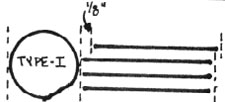 |
- JAN.
30 1935 DATE
- TOPE
KILLER TO RIGHT
- DIAL
DISTORTED AT 5 O'CLOCK
|
 |
- JAN.
30 DATE
- "DROOPY"
KILLER BARS
|
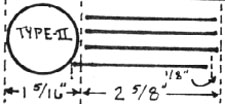 |
- JAN.
30 1935 DATE
- BOTTOM
KILLER TO LEFT
|
 |
|
NOTES
ON ODD VARIETIES AS OF JANUARY 1992:
- 5/8" Killers
/ Hal Vogel reports 1 H.C. / No Back-Up
- 1 15/16"
Killers / Hal Vogel reports 1 H.C. / No Back-Up
- 2 1/4"
Killers / Paul Skowron Reports 1 H.C. / No Back-Up
NATIONAL
STAMP EXHIBITION OF 1934
HAND CANCEL
TYPES
|
Three handcancelers
were in use at the Exhibition Post Office . . . two with short killers
and one with long killers. The short types ( I & II ), are very
similar except that the "DATE" and "TIME" slugs
in the postmarks are switched. As for the long killers, (
other than the normally centered "FEB", Type III ), it
is known that a second long killer variety exists with the word
"FEB" shifted left or right of center. This new variety
( Type IV ), is probably the result of a poorly functioning or "broken"
Type III canceler, not a fourth cancelling device. This Type IV
cancel moves out of alignment, in increments, both far right
and left of center.
Reproductions
of the four types are shown below:
|
|
TYPES
I, II
|

|
- SHORT
KILLERS WRAP AROUND CIRCLE
- TYPE
I IS SHOWN AT LEFT
- TYPE
II IS NOT SHOWN - "DATE & TIME" ARE SWITCHED
- BLACK
& RED INKS USED (REGISTERED USE)
|
|
TYPE
III
|

|
- LONG
KILLERS, ENDS VERTICAL
- "DATE"
& "TIME", TYPE I SEQUENCE
- "FEB"
SHIFTED TO THE RIGHT OR LEFT
- BLACK
INK IS USED
|
|
TYPE
IV
|

|
- LONG
KILLERS AS TYPE III
- "DATE"
& "TIME", TYPE I SEQUENCE
- "FEB"
SHIFTED TO THE RIGHT OR LEFT
- BLACK
INK USED
|
B.A.E.
II RECEIVING POSTMARK
SAN
FRANCISCO, CALIFORNIA
NORMAL
SIZE - 34mm
SMALLER
SIZE - 33mm
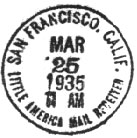
The
smaller size is shown above and may be used as an "overlay".
This
new type was noted by Gunnar Carlson on a cover purchased in a 1996 Polar
Bear Philatelics Auction
The vast
majority of "Second Cancelation" and " . . . delayed .
. . " mail serviced by Anderson in 1935 is marked on the back with
a "San Francisco" receiving mark. However, some slipped through
and are not backstamped.
Two basic
types exist, the common machine types
shown below . . .
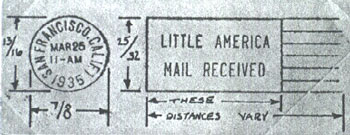
For unknown
reasons, there exist today 7 varieties of machine cancels. All appear,
at quick glance, to be the same . . . but they are not. The example above
shows dimensions of various elements of the cancel. Notice the length
of killer does vary!
. . .
and the uncommon hand type shown
below:
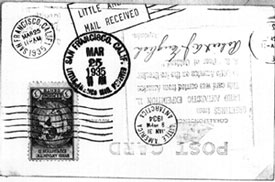
Hand
marks were used as favors, or on some crew mail. However, they were most
often used when a cover slipped through without a machine marking. Hand
type covers are uncommon, ones with both as shown above are even more
uncommon.
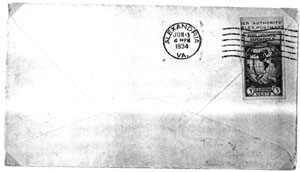
As the
above cover illustrates, it was after expedition and postal officials
inspected the Little America covers and sent them on for delivery that
any "receiving" marks were applied (dated June 8, 1934 on this
example). These marks were applied, usually on the back, at the post office
of the addressee. "Receiving" type covers from the First Cancellation
(undelayed) are uncommon because postal rules were strict in this regard
of backstamping ordinary mail (non-registered, special delivery, etc.).
Some
First Cancelation mail is incorrectly backstamped as a result of collectors
prevailing upon a willing postal clerk to bend the rules. The cover above
illustrates a legitimate backstamping as an extra stamp was affixed to
the rear of the cover for canceling.
Most,
if not all covers, are backdated sometime in late May or early June of
1934.
CONTINUED ON THE
NEXT PAGE
|

